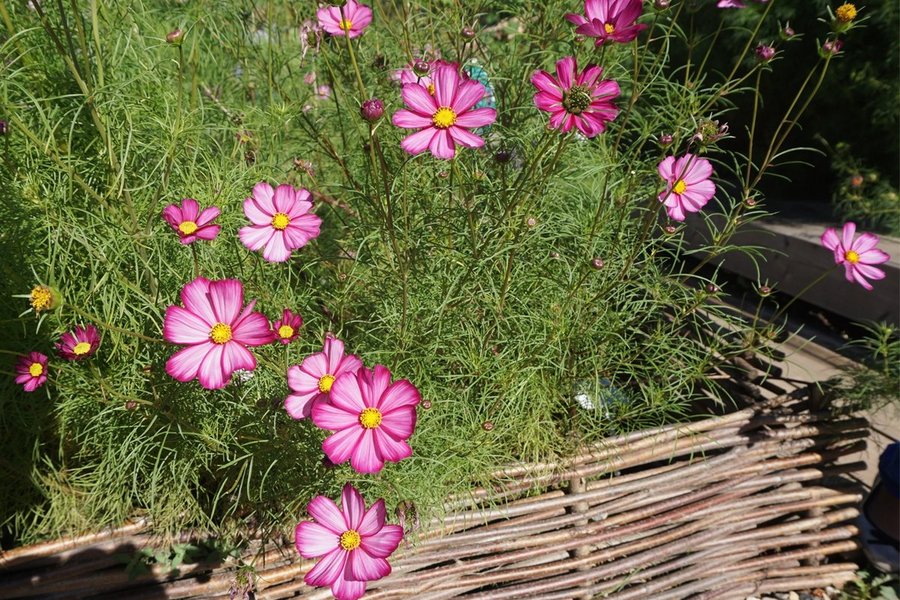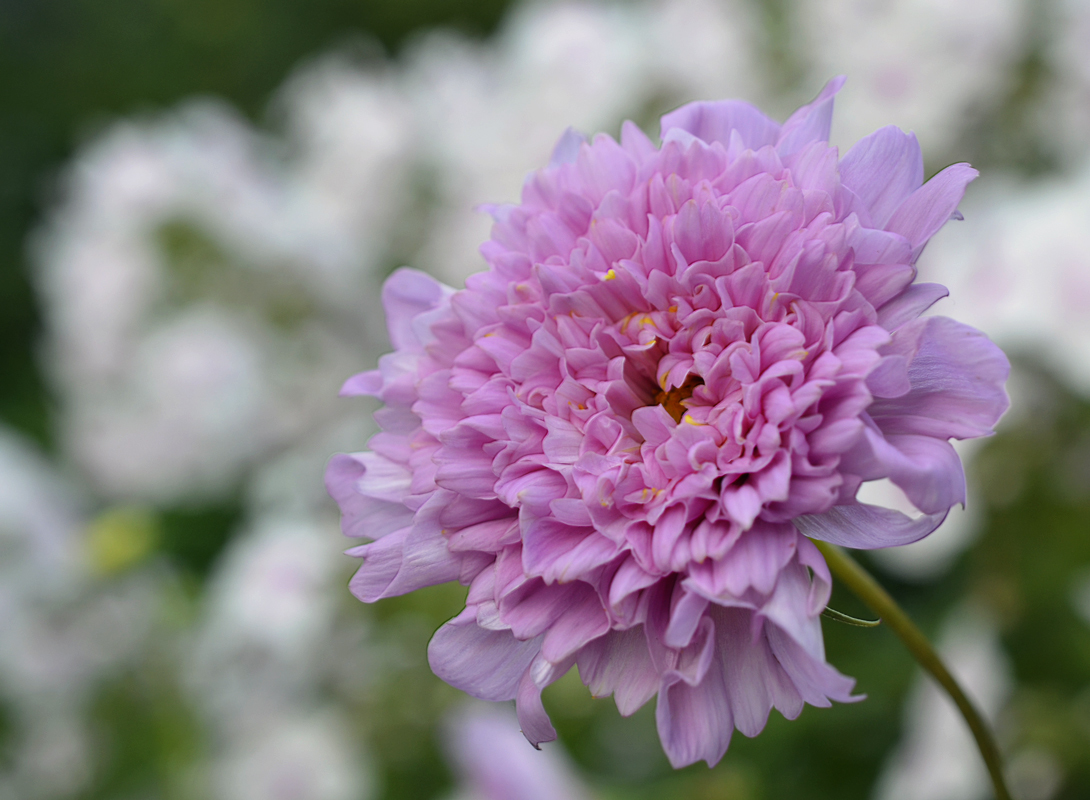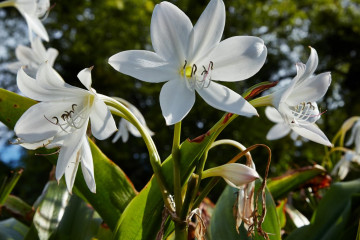Kosmeya flower
Content:
Many people know this plant as Moscow chamomile. Officially it is called kosmeya flower or cosmos (the official translation from Greek is decoration). Most often, you can see an annual in group plantings of a rabatok. Sometimes it is grown for cutting into bouquets.
In nature, there are more than 40 plant species. As a perennial flower, kosmeya exists in the tropical regions of America. It is especially abundant in Mexico. In Europe, the beauty appeared as a skid and is often found along roads, in wastelands and even garbage dumps.
In Russia, you can find 3 types of plants everywhere: double-feathery cosmea, sulfur-yellow and blood-red. Although in recent years, avid florists have begun to grow in their dachas and artificial varieties of Moscow chamomile, which differ in a number of features.
Description
The herbaceous plant belongs to the Asteraceae family. To know what a culture looks like, they carefully study the external structure. Space has a thin, well-branched stem, reaching a height of 0.5 to 1.5 m. You can recognize the Mexican aster by the following features:
- shoots are smooth, bright green with reddish streaks;
- openwork leaves oppositely located; there are oval plates with a pointed edge and thin needle-like;
- on the tops of the shoots, inflorescences-baskets with a diameter of 6-12 cm are formed.
Gives kosmeya flowers of various shades: white, golden, pink, red, purple. Lingulate petals frame a fluffy, spherical (sometimes flat) core of brown or black tubules with yellow anthers.
The kosmeya begins to bloom in early summer and smells fragrant until the frost. As a result, it gives elongated achenes with a tuft, which are very quickly carried by the wind through the garden.
Types and varieties
In Russia, 3 varieties of cosme are most often found. They differ among themselves in the shape and shade of inflorescences.
The main types of cosmos
| Name | Description |
|---|---|
| Double-feathery cosmea | It is a densely branching bush up to 1 m high. Numerous baskets are painted in white, pink, lilac, red shades in double inflorescences, yellow in small tubular ones. The petals have oval or wavy edges. |
| Sulfur-yellow kosmeya | It can be grown in a flower bed up to 1.2-1.5 m. The leaf segments are wider than that of the pinnate species. Inflorescences are small - up to 8-10 cm in diameter. Yellow kosmeya is collected from reed flowers with corrugated petals |
| Blood red | It stands out for its large flowers with maroon petals surrounding a black core. Their surface is matte, almost velvety. Unpaired leaves are painted in rich dark green |
The red-bloody perennial received another name - chocolate cosmeya, thanks to the specific aroma exuded by the flowers.
Due to the diligence of breeders, gardeners have recently been able to grow another group of Moscow chamomile flowers. True, terry kosmeya has not yet been presented as a separate species in the official classifier. You can recognize it by the lush, astro-like inflorescences of pink, yellow, orange, red shades.
On the basis of the available species, beautiful varieties of perennial cosmos were bred, which immediately became popular with gardeners.
Kosmey varieties
| Name | Features of the |
|---|---|
| Sea shell | On a meter-long bush, inflorescences are formed that outwardly resemble shells. They are large, colorful |
| Cosmeya sensation | Differs in early flowering. It stands out with long stems (up to 1.2 m), inflorescences up to 10 cm in diameter, which can be monochromatic or bicolor |
| Bonbon Rose | Refers to the terry group of cosmes. Gives lush, astro-like flowers of a pale pink hue |
| Carousel | Very decorative 1 meter shrub with heavily dissected foliage. The main feature is white petals in a pink border |
| Sunny orange | Low-growing, no more than 30 cm, bush with pubescent erect stems. Small inflorescences barely reach 6 cm in diameter |
| Terry button | Several varieties have been created under this name: · An ordinary bush 1.2 m tall - with double and semi-double baskets of various shades; Burgundy - reaches a height of 0.8 m, gives inflorescences 7-10 cm in diameter; Bicolor - with double pinkish-white flowers |
| Pikoti | The variety attracts with its unusual color. Looking at the flowers, one gets the impression that the master is decorating the fabric - the white petals framed by a carmine-red border are so originally decorated by nature. |
Growing cosmos from seeds
Mexican aster in nature reproduces independently, scattering seeds around itself. Gardeners prefer to breed cosmea as an annual plant. Therefore, they try to collect achenes in the fall in order to resume the rabatka next year.
Landing features
Growing cosmos is a simple process that even a beginner can easily handle. The seeds of the plant retain good germination for 3 years after being harvested.
If you liked kosmeya growing from seeds when to plant, it is determined in one of the ways:
- if a seedling method is planned, then planting is carried out in March-early April in boxes;
- they sow in open ground in spring as soon as the snow melts;
- some growers practice sowing before winter, taking into account the natural way of propagation of the culture.
Cosmos seeds are cold-resistant, so you don't have to worry about night frosts. But even in a southern climate, when sowing on a flower bed, flowering will not begin until July. For summer residents of the Moscow region and more northern regions, it is recommended to use the seedling method.
How to grow seedlings
To admire the flowers of cosmos at the beginning of summer, they take shallow boxes and fill them with a sand-peat mixture. This is followed by the following algorithm:
- each seed is slightly pressed into the ground, without deepening - light should fall on them;
- moisten the earth;
- the box is covered with transparent film and placed on the windowsill.
The room maintains a temperature of + 18-20 ° C until shoots appear. This will happen in a couple of weeks. At this point, the shelter is completely removed and the sprouts are allowed to rise to a height of 10 cm.
A picking of seedlings is carried out in other containers, maintaining a gap between plants of 10-15 cm. Before transferring to open ground, the cosmea is kept in a room with a temperature of + 16-18 ° C.
To exclude the thinning procedure, initially you can plant 2-3 seeds. in separate cups.
Sitting in the open ground
The cold resistance of the plant allows sowing cosmos directly into flower beds. This procedure is carried out in most regions in April. In the southern regions, you can make out rabatki from the end of March.
Any scheme is used: ordinary or square-nested. You need to plant so that there are no more than 6 plants per 1 square meter, otherwise they will interfere with each other. The optimal spacing between cosmeas is 0.3-0.5 m.
The holes are not made deep - up to 1 cm. Water it carefully so that the seeds do not wash out of the holes. When shoots appear, the plants are looked after as if they were mature bushes.
Cosmeia care
Before planting seedlings in a flower bed, shallow pits are prepared. The distance between them will depend on the height of the variety.For tall bushes, it is advisable to immediately install a support by driving stakes next to the holes.
The depressions are watered and only then the seedlings are installed in them. Seedlings are added dropwise and watered again. In the future, irrigation is carried out as needed.
Care activities:
- in a hot dry summer, kosmeya is watered once a week, adding 3-4 buckets of water under the bush;
- on fertile soils, one-time feeding is enough (in spring or autumn); on depleted soils, superphosphate, rotted manure or Agricole are applied every month;
- throughout the summer, cosmea is periodically sprayed with a growth stimulator "Bud";
- wilted inflorescences are immediately pruned to stimulate the emergence of new buds.
Having chosen the largest baskets on the bush, gauze bags are put on them after full maturation. This will prevent the ripe seeds from falling to the ground.
In order not to complain about why the cosme bushes have slowed down in growth, they regularly loosen the soil and control weeds.
As for diseases and pests, summer residents will not have to worry about this. The cosmos has a strong immunity, which became another reason for the popularization of culture.
In dense plantings, slugs and snails can be seen. They are collected by hand or set near a flower bed with beer traps (parasites are too hungry for a hop drink). For prevention, you can sprinkle the ground around the bushes with crushed egg shells or ash.
In the southern regions, the plant is grown as a perennial. Before freezing, the bush is cut off, leaving small columns of 10-15 cm. Cover with a thick layer of fallen leaves and spruce branches.
In the northern regions, the bushes are not kept for the winter. They are completely removed from the flower bed, the earth is dug up.
So that from summer to frost, the cosmea pleases with its beauty, planting and care in the open field is carried out with knowledge of the rules of agricultural technology. You should not look at the fact that the culture is unpretentious in cultivation. She will always thank you for her care and attention with lush flowering.





















